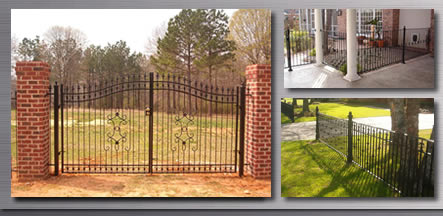


Iron Drive Gates
Iron Walk Gates
Iron Fencing
Access Systems
Firewood Racks
Log Cabin Siding
Wood Fencing
Contact Us
Easy Routine Product Maintenance
EASTERN CEDAR FENCE
Bleaching a cedar fence can restore it to its natural
red-orange color. Like all other types of wood, cedar also loses its natural color due to its exposure to sunlight and other elements. Cedar wood is derived from several different classes of cedar, such as Eastern cedar, Spanish cedar and red cedar. To revive the beauty of a cedar fence, all that is needed is oxygen bleach and some home materials.
Eastern Aromatic Cedar is the type of wood that ACME uses for fencing projects. The technique below is not to be used with fences that have been stained.Tools and Materials
- Oxygen bleach
- Water
- Scrub
- Bucket
- Pump spray bottle
- Water hose
Step 1 – Wait for Perfect Timing
If the cedar fence is situated in an open area open to direct sunlight, wait for the time of the day when the fence is completely shaded. Sunlight has damaging effects on the color of wood being bleached. It also causes the wood to change its hue. If the fence is located in a shaded area, there is no need to wait for the sunlight to be blocked by clouds. The fence can be bleached right away.
Step 2 – Mix an Oxygen Bleach Solution
Mix the oxygen bleach with water to form a solution in a bucket. The proportion would depend on the instructions set by the manufacturer. Check the instructions on the bleach product to confirm the right ratio between bleach and water. Typically, 1:12 ratio is okay. Be sure not to use chlorine bleaches because this may cause a discoloration on the wood.
Step 3 – Fill the Pump Spray Bottle with the Solution
A pump spray bottle allows efficient use of the solution and ensures that none of the solution is put to waste. If it is not available at home, purchase one at a local supply store. These bottles are cheap and come in different sizes. Purchase one that has at least a capacity of 500 ml or 1L. Fill the bottle until it’s almost full.
Step 4 – Soak the Cedar Wood in the Solution
To bleach the wooden fence, spray every surface until it gets totally soaked in the solution. Allow the solution to stay on the wood for about 30 minutes. This will allow the product to work its bleaching effect into the wood.
Step 5 – Scrub the Wooden Fence
Scrub the wooden fence with a brush to remove any dirt on the surfaces of each wood. The scrubbing motion will also allow the oxygen bleach to work its way through the wood. It also removes any dirt that may hinder the bleaching effect. While brushing, notice how the cedar comes back to its natural color.
Step 6 – Rinse Well with Water
After scrubbing, rinse the cedar with water. Use a water hose to flush all the bleach and dirt from the wood to reveal a more natural looking wood. Make sure to rinse thoroughly. Any oxygen bleach left on the wood may continue to bleach the wood and cause unevenness in hue.
When working with oxygen bleach or any type of bleach, always wear protective gloves because the solution may irritate the skin.
IRON FENCE
The maintenance on your fence depends on the type of finish and product you selected. Most of our fences have a very durable E-Coating or Powder Coated finish and neither of these finishes require maintenance. However, your gates are another story!GATE HINGE CARE FOR WOOD OR IRON GATES
Hinges for gates are often the first part of a gate to deteriorate and wear out, due to the constant use they are subjected to. It is important to keep up with properly maintaining any gates and fences you have, and most especially the moving parts like gate hinges and locks. If you do not properly maintain hinges for gates, or other movable gate parts, you will find that they will begin to not work properly and can detract from the look of your fence or gates. They can even become a security issue, making it easier for would-be thieves to break into your home or property. Read on to find out what types of problems can arise with hinges for gates and how you can prevent them from happening.
The very first thing to be careful of with gate hinges is rusting. The build up of rust is mainly brought about by water and oxygen combining, unabated, on a piece of metal. During the rainy season, when almost everything outdoors is wet, rust build up is an almost inescapable reality. The problem with rust is that it weakens the gate hinge, and therefore the gate, making it sag. Sagging is the unfortunate situation when one of the two sides of the gate is higher than the other. A sagging gate not only looks like an eyesore, but will not work properly because the hinge on the gate is not aligned properly. Therefore, if nothing is done about rust, you might see yourself forking out money to get a new gate installed.In order to avoid rusting, you must oil your gate hinges with used motor oil or grease. By simply pouring it over a joint, you will be increasing the lifespan of the gate by at least 5-10 years. However, the application of grease and oil must be done regularly if you want to reap the best results. In addition to reducing the likelihood of rusting, greasing also kills termites that bring about rotting of the wood of the surrounding gate or fence, as well as preventing the squeaky sound gates normally make when they are worn out at the hinges. Just be careful that when you pour the oil or grease on the hinges, the rest of the gate does not become covered in the oil or grease, ruining the wood.
Possibilities are limitless with ACME call today for more information (318)237-9654.